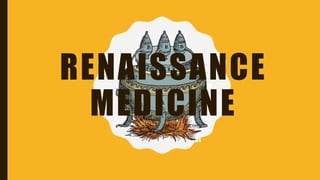
Renaissance medicine by TriAngels (medical group) history of medicine
- 2. RENAISSANCE CIVILISATION • From 1400 to 1700 CE (Common/Current Era) • Is the period of progress in European medical knowledge, and a renewed interest in the ancient ideas of the Greeks and Romans. • During the 15th century Western civilisation experienced a process of profound change, which historians call the Renaissance (meaning 'rebirth').
- 3. SIX KEY CHANGES Government The economy boomed and trade prospered. People could afford doctors. New World The discovery of America by Columbus meant that new foods and medicines were brought back from the New World. Printing Press The invention of the printing press allowed new ideas to spread more quickly around Europe. In the 15th century AD, there was a 'rebirth' of European civilisation.
- 4. Revival of learning Universities established schools of medicine. The Renaissance saw the beginning of scientific method New Weapons (especially gunpowder) led to soldiers getting different sorts of wounds, which battlefield doctors had to deal with. Artists (such as Michelangelo, Leonardo da Vinci and Titian) revolutionized painting this led them to study the body in more detail, and was connected to improved knowledge of anatomy
- 5. GROWTH OF KNOWLEDGE • Although the Renaissance saw an improvement in medical knowledge, particularly of anatomy and physiology, many people rejected the new ideas. • Further, doctors still did not manage to use their discoveries to develop better cures for their patients, because they had still not discovered the role that germs play in causing disease. 15th-century manuscript illumination of a public dissection Anatomy Theatre inside Archiginnasio where the first public dissection of a corpse took place in 1315 Bologna Italy
- 6. DIAGNOSIS AND TREATMENT • Methods of diagnosis in the Early Modern Age did not change from the time of the Middle Ages. • Doctors were utterly unable to cure infectious disease, and were powerless in face of diseases such as the plague and syphilis. • They did get some new drugs (eg quinine for malaria) from the New World, but generally treatment was a mixture of superstition and errors. 17th-century engraving by Paulus Furst, of a physician wearing protective clothing, including a mask, to protect him against the plague
- 7. RENAISSANCE PUBLIC HEALTH Rats, lice and fleas were a part of people's everyday lives in Early Modern times, so the need for public health measures was great - but it took the plague of 1665 to get the authorities moving.
- 8. Early Modern towns were similar to Medieval towns. They did not have systems of sewers or water pipes. Garbage and human waste was thrown into the streets.
- 9. Despite the generally casual attitude to dirt, during the 1665 plague London did nevertheless establish some public health provisions. 'Surgeons' were appointed, who examined the dead to establish the extent of the plague. Bills of Mortality were published, to publicize the course of the disease. 'Examiners' and 'searchers' were appointed, who established whether members of a household had contracted the plague. Constables were appointed, who made sure no one left such houses. Bodies were buried at night in huge pits, and mourners were not allowed to attend. 'Pest houses' were set up, to quarintine sufferers. Householders were ordered to collect all waste, which was then removed by 'rakers'. Stray pigs, dogs, rabbits and cats were killed. These measures unfortunately did not stop the spread of the plague, which only ended when the weather turned cold
- 10. RENAISSANCE DOCTORS Medicine in Early Modern times was making some progress - but most people's doctors had little or no training. Early physicians The Early Modern Age saw advances in theory, but not in practice. The most advanced Early Modern physicians were usually town-based, and also: •were well educated and trained •did 'scientific' research •were prepared to contradict the accepted authority •disseminated their findings •relied on royal support •had limited success
- 11. However, they charged very high fees and only the richest people could afford them. The medicine available to ordinary people relied on the amount they could afford. The people they turned to for medical advice included: I. Country doctors - lower fees than town doctors, but not well-trained II. Barber-surgeons - who were paid to perform small operations III. Apothecaries (chemists) – no medical training, but sold medicines and groceries IV. Quacks - travelling barbers, tooth-pullers, who sold medicines which were supposed to cure everything V. Wise women, neighbours and local 'witches' 16th-century woodcut, depicting (right) medical treatment of a skin disease and (left) blood letting, by barber surgeons in a barber shop
